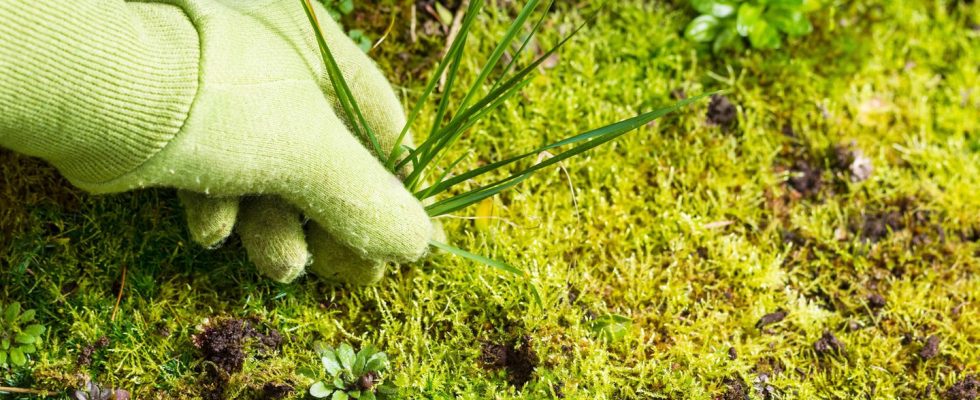Green maintenance
Moss in the lawn: A handful of tips against annoying thatch
Moss mainly spreads on lawns when there are little or no nutrients left in the soil. Five tips against thatch.
Mosses are one of nature’s most fascinating creations. But allotment gardeners in particular don’t like the millions of years old plants. Because moss in the lawn is frowned upon. Five tips against thatch on the meadow.
In addition to various garden weeds, mosses are the most unpopular guests in allotment gardeners’ plots. At least when they are in the Spread the lawn of the property. Mosses have a bad reputation. They are an important part of the ecosystem in many of our world’s landscapes. If they spread across lawns, this is a sure sign that the meadow grasses are hardly getting any nutrients from the soil. For better or worse, they have to leave the field to less demanding plants such as weeds or mosses. For example, mosses get their nutrients from rainwater.
With the rising temperatures, the blades of grass on many properties and in allotment gardens are now waking up from their winter dormancy. But various mosses have often spread across the lawn over the winter. If you don’t feel like doing that, you should thoroughly renovate your meadow. And this is how it works:
- Scarify the lawn
- Check and neutralize the pH value of the soil
- Fertilize lawn
- Apply soil activator or compost
- Reseed the lawn (use certified organic seeds)
1. Scarify/aerate the lawn
If you want to remove the moss from your lawn, you can’t avoid scarifying it. Plucking the moss out of the lawn by hand is not only extremely laborious, but also work that never ends. Electric scarifier are equipped with small, sharp blades that cut small furrows in the lawn, making it more permeable. The side effect is also extremely useful. The scarifier also catches a lot of thatch made from moss, weeds or grass roots.
Important: You can dispose of moss and other lawn thatch in your own compost. Be sure to mix the green waste with other garden waste beforehand so that it doesn’t clump together.
2. Check pH value and lime
If you have moss in your lawn, this is a sure sign that the lawn is not receiving enough nutrients. This is usually because the soil is too acidic, i.e. has a pH of 5.5 or less. With a pH soil test you can easily check this within minutes. As a first countermeasure it is helpful to remove the acid in the soil Garden lime to neutralize. Because doing it by hand is tedious, especially for larger areas, and usually doesn’t work evenly, it’s worth it Spreader truckto get the right dosage.
3. Fertilize the lawn
Once the meadow is well ventilated again and the soil is neutralized, the stalks need a growth booster. Only about high-quality, organic lawn fertilizer The urgently needed nutrients get into the soil. These are generally significantly less contaminated with heavy metals than mineral fertilizers. Organic fertilizer can also be applied with new or reseeding. A good middle ground could be organic-mineral lawn fertilizer be. To keep in mind: Use the grass clippings after the next moat as natural fertilizer. It contains important nutrients that you withhold from the soil when you spread the cuttings on the compost after mowing.
4. Apply soil activator (or compost).
Which brings us directly to the fourth act of lawn renovation. Before new lawn seeds come into play in the final step, you should give the soil a further and, if possible, sustainable boost of nutrients. This is particularly possible with the humus miracle weapon called compost. When incorporated into the soil, the compost acts like organic fertilizer thanks to its humus layer. You can achieve a similar effect with one Soil activatorwhich is applied as granules and brings the microorganisms into the soil in concentrated form.
5. Sow the lawn
The fifth and final act is about sowing new lawn seeds and giving the area the necessary density and strength again. Here too it is worth having one Spreader truck to take help. If you don’t want to buy it separately, you can rent it and other garden tools from many hardware and garden centers for a fee. It is important that you do as much as possible certified seeds put out. You can recognize this by the label RSM (Regular Seed Mixture), which guarantees that the mixture only contains lawn seeds from first-class grass varieties. Depending on the provider, you should budget around 60 to 80 euros for a lawn area of 200 square meters. This is particularly true: If you buy cheaply, you sow at least twice.
Getting rid of moss in the long term: This is how it works
The renovation described is complex and takes time. If you want to avoid having to subject your lawn to such a treatment every year, you should ask yourself why the moss grows at all and start there. Answer A: Moss thrives even in the shade, shaded grass quickly stops growing. Seeds optimized for partial shade can solve the problem. However, if hedges or other obstacles cut off the lawn completely from sunlight, grass is a hopeless case at this point. Answer B: Blades of grass need moisture – but in a healthy amount. In the worst case scenario, waterlogging and constant wetness can cause the roots to rot. The cause is usually the soil that is too compacted. The only thing that helps here is digging and mixing some sand into the soil, which is much more permeable to water.
You might also be interested in:
This article contains so-called affiliate links. Further information are available here.


